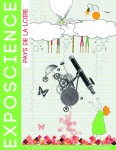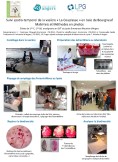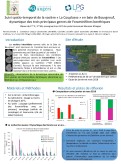Benthic foraminifera are micro-organisms inhabiting marine sediment. While they are excellent bio-indicators of coastal water quality, they remain poorly known by the general public.

To present this scientific area to younger generations, the laboratory of Planetology and Geodynamics (LPG) of the University of Angers has implemented a collaboration with the high school Emmanuelle Mounier (Angers). This collaborative science project involves students from the science division in their second year of high school.
Collaborative science project between the LPG and the high school Emmanuel Mounier (Angers)
Initiated by Julien Richirt in 2016-2017 and run by par Constance Choquel and Charlotte Le Kieffre in 2017-2018
E. Mounier high school students, with the LPG, followed a long-term monthly survey of the foraminiferal fauna of an intertidal mudflat located on the Atlantic French coast. This project, initiated by Julien Richirt in 2016, is now part of Constance Choquel thesis.
The main aim of the mudflat survey is to determine the foraminiferal response to local (oyster farming) and global changes (global warming).
|
The objectives were: - Connect high school students with the research community, - Link teaching with innovative and modern research thematic, - Familiarize the high school students with all aspects of the research, from sample treatment and biomonitoring raw data analysis, to data interpretation, - Give rise to vocations, trigger their scientific interest. |
The scientific developed activities were:
1. Build a determination key of the main species encounter during the survey (Ammonia, Elphidium, Haynesina) that the students could use during the sample observation with the stereomicroscope.
2. Study the spatial and temporal foraminiferal distribution in the mudflat.
Scientific background
The collaborative science project offered to the E. Mounier high school students is part of the project “Mudsurv” initiated in March 2016 and funded by OSUNA for the implementation of a spatial and temporal survey of the Bourgneuf Bay (Atlantic French coast).
The project stakeholders are the Laboratory of Planetology and Geodynamics (LPG) of the University of Angers and the laboratory Mer Molécules Santé (MMS) of the University of Nantes.
A monthly in situ survey in the Bourgneuf bay mudflat will allow a better understanding of intertidal mudflat function. The monitoring activities looks at:
- the microphytobenthos for the primary production: the microalgae, including diatoms, form a biofilm, assimilate atmospheric carbon and transfer it in the trophic web.
- the macrofauna
- the meiofauna, including foraminifera who feed on the microphytobenthos
- the sediment geochemistry, in particular the monitoring of nitrogen and phosphate nutrients which are key elements to understand the dynamics of microalgae and foraminiferal dynamics.
In the frame of “Mudsurv”, the students worked on sediment samples from January and March 2018 in order to observe the seasonal variability of foraminiferal abundances. The main genus observed were: Ammonia, Haynesina and Elphidium. Their work will be part of the dataset of the biomonitoring project analyzed in Constance Choquel thesis.
A few key dates of the collaborative science project:
- 17 January and 18 March 2018: sampling in the Bourgneuf Bay
![]()
13 March 2018: lecture from Constance Choquel and Charlotte Le Kieffre at the high school Emmanuel Mounier: introduction to foraminifera and presentation of the science collaborative project
- 18 and 24 April 2018: students came to visit the LPG laboratory, introduction to different lab activities

- 23 May 2018: two groups of 4-5 high school students hold a stand with poster and living foraminifers’ observation at Exposciences (an initiative that puts young people at the heart of scientific and technical projects to exchange between groups of young people and with the public).
This step allowed them to better understand the importance of science popularization to share their results and the environmental issues of mudflat surveys with a wide public. This project was also supported by the local association of Francas du Maine et Loire.




















